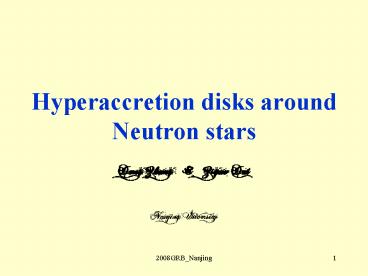Hyperaccretion disks around Neutron stars PowerPoint PPT Presentation
1 / 22
Title: Hyperaccretion disks around Neutron stars
1
Hyperaccretion disks around Neutron stars
- Dong Zhang Zigao Dai
- Nanjing University
2
Outline
- Models of GRB inner engines
- Neutrino-cooled accretion disks
- X-ray flares
- Center objects to be Neutron Stars
- Hyperaccretion disks around Neutron stars
- Future work
3
Models of GRB inner engines (from Nakars PPT,
2007)
NS Quark star
NS-NS NS-BH
WD - WD
LMXB
Phase transition
Merger (AIC)
Merger
AIC
msec magnetar
gt1016 G magnetar
Accretion disk Black Hole
Quark star
4
Neutrino-cooled accretion disks
- High accretion rate 0.01-10 Msun/s
- Short accreting timescale 0.1-1s
- High density, temperature and pressure 109- 1011
g cm-3 , 1010 -1011K - Optically thick
- Neutrino-cooled
- 1051 -1053erg/selectron-positron capture,
electron-position pair annihilation, nucleon
bremsstrahlung, plasmma decay - Different types of flows ADAFs, CDAFs, NDAFs
Ref. Eichler et al. 1989 Paczynski 1991 Narayan
et al. 1992 Popham et al. 1999 Narayan et al.
2001 Kohri Mineshige 2002 Di Matteo et al.
2002 Lee et al. 2005 Gu et al. 2006 Chen
Beloborodov 2007 Liu et al. 2007 Janiuk et al.
2007
5
X-ray flares
- Fragmentation of a rapidly rotating core (King,
2005) - Magnetic regulation of the accretion flow (Proga,
Zhang, 2006) - Fragmentation of the accretion disk (Perna et al.
2005) - Differential rotation in a post-merger pulsar
(Dai et al. 2006) - Infalling tidal tail of material from NS (Lee,
Ramirez-Ruiz, 2007)
Lazzati et al. (2008)
Metzger et al. (2008)
6
Center objects to be Neutron Stars
- X-ray flares of short GRBs are due to
magnetic reconnection-driven events from highly
magnetized millisecond pulsars.
B-field (poloidal)
core
B-field (toroidal)
crust
Dai, Wang, Wu Zhang, 2006, Science, 311, 1127
(??)
7
- X-ray flares after some GRBs may be due to a
series of magnetic activities of
highly-magnetized, millisecond-period pulsars. - The GRBs themselves may originate from transient
hyperaccretion disks surrounding the neutron
stars via neutrino or magnetic processes. - Hyperaccretion disks could also occur in type-II
supernovae if fall-back matter has angular
momentum.
8
Hyperaccretion disks around Neutron stars
- Outer disk-similar to the BH-disk
- Inner disk-the entropy conservation
self-similar structure - (Cheavlier 1989 Medvedev 2001, 2004)
- Similar to BH-disk- high accretion rate, short
timescale- high density, temperature and
pressure- optically thick, neutrino-cooled-
ADAFs, NDAFs - Different to BH-disk- the neutron star surface
prevent heat energy from being advected inward - - the inner region to be hotter and denser-
shock wave or not
9
Chen Beloborodov 2007
10
Two region steady disk model
Advection-dominated outer disk
Self-similar inner disk
NS
Shock wave ??
11
- Thermodynamics and microphysics mass continue
equation angular momentum equation energy
conservation equation--- pressure and charge
equation (EOS)--- neutrino cooling rate---
beta-equilibrium - Two models a simple model and a more elaborate
model - Size of the inner disk
- Structure distribution
- Efficiency of neutrino cooling
- Comparing with the BH-disk
12
Zhang Dai 2008, ApJ, in press
- When the accretion rate is sufficiently low, most
of the disk is advection-dominated, the energy is
advected inward to heat the inner disk, and
eventually released via neutrino emission in the
inner disk. - When the accretion rate is moderate, the size of
the inner disk reachs its minmium value, since
the outer disk flow is mainly NDAFs. - If the accretion rate is large enough to make
neutrino emission optically thick, then the
effect of neutrino opacity becomes important.
13
(No Transcript)
14
The equivalent adiabatic index and the
electron fraction Ye in the elaborate model as a
function of radius. The equivalent adiabatic
index can be expressed by
15
Luminosity and accretion rate solid line
corresponds to the whole disk of a neutron star,
dashed line to the inner disk, dotted line to the
outer disk, and dash-dotted line to the black
hole disk.
16
Prospect ??
- Neutrino annihilation Neutrinos from a
hyperaccretion disk around a neutron star will be
possibly annihilated to electron/positron pairs,
which could further produce a jet. This could be
helpful to draw the conclusion that some GRBs
originate from neutrino annihilation rather than
magnetic effects such as the Blandford-Znajek
effect. - Ultra-strongly magnetic fieldFor magnetars, the
magnetic fields could play a significant role in
the global structure of hyperaccretion disks as
well as underlying microphysical processes, e.g.,
the quantum effect (Landau levels) on the
electron distribution and magnetic pressure in
the disks could become important.
17
Neutrino annihilation (1)
Neutrino luminosity and neutrino annihilation
luminosity
18
Neutrino annihilation (2)
Neutrino annihilation luminosity with different
alpha and boundary condition.
19
Neutrino annihilation (3)
The total integrated luminosity out to each
radius for BH-disk and NS-disk.
20
Ultra-strongly magnetic field
Density, pressure and temperature as functions of
radius for the NS surface magnetic field to be
1015, 1016, 1017 Gauss.
21
Summary
- Newborn neutron stars have been invoked to be
central engines of GRBs in some origin/afterglow
models. - Hyperaccretion disks surrounding pulsars could
provide an energy source for some explosions via
neutrino/magnetic processes. - Compared with the black-hole disk, the neutron
star disk can cool more efficiently and produce a
much higher neutrino luminosity. - Some GRBs may originate from neutrino
annihilation. - The ultra-highly magnetic fields for magnetars
could play a significant role in the global
structure of hyperaccretion disks
22
Thank You !

